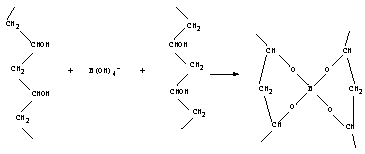|

|

It's the Slime Time of Your Life
|
Developers:
|
Eileen Mika
Bensalem High School
Bensalem, PA
|
Eugene Dougherty, Ph.D.
Senior Research Chemist
Rohm and Haas Company
Spring House, PA
|
|
|
Topic Area:
|
Polymerization
|
|
Grade Levels:
|
K through 12
|
|
Discipline:
|
Chemistry
|
|
Goals:
|
Students will be introduced to the concepts of polymerization.
|
|
Objectives:
| A high school student, upon completion of this lab, will be able to:
-
explain the basic concept of polymerization
-
understand the dissolution theory of "like dissolves like"
-
apply the concept of hydrogen bonding as it relates to water as a solvent
-
understand the function of crosslinkage
-
relate to the dynamic equilibrium and restoration (memory) of a polymer
-
become familiar with the concept of viscoelastic and mechanical behavior of polymer networks
-
name at least five other common polymers (natural and/or synthetic)
|
|
Vocabulary:
| Polymerization - Joining of monomers to produce a long chain of small repeating units. This may be brought about through either addition polymerization or condensation polymerization.
Addition polymerization - Process where many monomers bond together to form the growing polymer.
Condensation polymerization - Formation of a polymer by the removal of small pieces of the monomer - usually water.
Borax - Common name for sodium tetraborate decahydrate--NA2BO4.10H20.
Copolymerization - Process by which two different monomers join to form one large polymer chain.
Crosslinkage - Bridges which hold together two or more polymer chains.
Homopolymerization - Polymer formed from only one kind of monomer.
Monomer - Small molecules that can combine with each other to form polymers.
Polymer - Large molecule formed by the linking of monomers, usually 1,500 units and weighing approximately 30,000 MW.
PVA - Poly(vinyl alcohol), which is formed by addition polymerization.
Slime - Gelation product of PVA and Borax.
Vulcanization - Formation of synthetic rubber by crosslinking with sulfur.
|
|
Materials:
|
Chemicals available from:
Flinn Scientific, Inc.
P.O. Box #219
Batavia, IL 60510
(312) 879-6900
-
Poly(vinyl alcohol)
|
DESCRIPTION
|
CATALOG #
|
SIZE
| |
99% hydrolyzed granular
|
PO203
|
25g
| |
|
PO153
|
100g
| |
|
PO154
|
500g
|
Or
|
DESCRIPTION
|
CATALOG #
|
SIZE
| |
ready-made
|
PO209
|
500 mL
| |
|
PO210
|
1 liter
| |
4% PVA aqueous
|
PO211
|
4 liter
|
Comment: The granular PVA has an indefinite shelf life, while the ready-made 4% aqueous PVA has a poor shelf life, unless kept cool and uncontaminated. Making PVA from the granular stock however, can be very tricky, time consuming and frustrating. PVA in water tends to clump very easily!
-
Sodium tetraborate decahydrate
|
DESCRIPTION
|
CATALOG #
|
SIZE
| |
powder (Borax)
|
SO334
|
100g
| |
|
SOO49
|
500 g
|
Or
|
DESCRIPTION
|
CATALOG #
|
SIZE
| |
ready-made
4% Borax solution
|
S0363
|
500 mL
| |
|
S0363
|
1 liter
|
-
one polystyrene cup OR a plastic bag per student
-
one wood splint or popsicle stick for stirring (if using a cup) per student
-
two 50-mL beakers or graduated cylinders labeled PVA and Borax respectively
-
food coloring is optional
|
|
Background Information:
|
Polymerization is a very important chemical process which produces many products found in our daily living. Artificial fibers (nylon, dacron), synthetic rubber, plastics (vinyl, polyethylene, PVC pipes), chewing gum, starch, wool and paint are just a few polymer products. Polymerization is brought about by the joining of small molecules to form long chains containing a repeating group. These small molecules are referred to as monomers. The joining of monomers can be achieved by the processes of addition polymerization or condensation polymerization. Chemists vary the use of catalysts, the choice of monomers and the selection of other conditions to control the reaction.
The Chemistry by which slime is produced involves the borate ion crosslinking with the PVA. PVA is used as a thickener, stabilizer, and binder in cosmetics, paper cloth, films, cement and mortars. The structure of poly(vinyl alcohol) is:

Borax hydrolyzes in water to produce a boric acid and the OH-ion
(B4)7-2(aq) + 7 H2O -- 4 H3BO3(aq) + 2 OH-(aq)
The Boric acid further reacts with water to form a borate anion.
H3BO3(aq) + 2 H2O - B(OH)4-(aq) +H3O+(aq)
The tetrahedral borate ion "crosslinks" with the poly(vinyl alcohol) to yield slime and water.

Slime is a non-Newtonian fluid that is dilatant. That is, under stress, the material dilates or swells. Other stress-thickening materials are quicksand, wet beach sand, starch solution, some printer's inks and Silly Putty®.
Under low stress, such as slowly pulling on the material, it will flow and stretch. If you are careful you can form a thin film. Pull sharply (high stress) and the material breaks. Pour the material from its container then tip the container up slightly, the gel will siphon. Put a small amount of material on the table top and hit it with the palm of your hand, there is no splashing or splattering. Throw a small piece on a hard surface, it will bounce slightly. Stuff the material through a small hole in your hand and "die swell" occurs as it emerges.
See how many characteristics and observations your students can come up with. Most of all have fun!
|
|
Teacher's Note:
|
If PVA is not available or you prefer not to work with it, you may use guar gum, another addition polymer, instead of PVA. Guar gum is available from Flinn Scientific Inc. and can be prepared by mixing 3-4 grams of 500 mL of water by mixing vigorously. Combine this solution with 20 mL of the 4% Borax solution.
|
|
Procedure:
|
-
Measure out in a graduated cylinder or beaker, 20 mL of 4% poly(vinyl alcohol)* and pour into a small cup (or a zip-lock bag).
*If you decide to make a 4% PVA (40 g/L) from the granular stock, allow at least 1-2 hours to prepare about one liter. The PVA powder must be added very slowly while continuously mixing. Dissolution occurs best around 90 degrees C.
-
You may add a few drops of food coloring if you wish.
-
Add 4-5 mL of 4% by weight borax solution to the PVA and stir with a wood splint (if using the plastic bag, seal the top and knead the two solutions together).
-
The mixture will begin to solidify and finally form a gel. Remove the slime from the beaker and shape it with your hands.
|
|
Observations and Questions:
| -
Record as many observations as you can about the properties, appearance and nature of slime.
-
Does it flow? Explain.
-
Does it fracture (crack)?
-
Can it be flattened?
-
Does the temperature change as it flows or when you stretch it?
-
Will it bounce?
-
Squeeze the material through a small hole formed in your hand. What happens?
-
Write a paragraph describing the polymer you have just made.
|
|
References:
| -
Casassa, E.Z., Sarquis, A.M., and Van Dyke, C.H., "The Gelation of Polyvinyl Alcohol with Borax", Journal of Chemical Education, Vol. 63, #1, January, 1986, p. 57-60.
-
Sarquis, A.M., "Dramatization of Polymeric Bonding Using Slime", Journal of Chemical Education, Vol. 63, #31, January 1986, p. 60-61.
Special thanks to John A. Stocks, Dr. Dougherty's lab technician for all his help, patience and encouragement!
|
|
Teacher Demonstration:
|
Shishkaballoon Trick:
This trick demonstrates quite dramatically the "memory" of the polymer. The point pushes through a loose space in the polymer which then tries to heal itself.
|
|
Materials:
|
-
Sharply pointed wooden meat skewers OR a magician's needle
-
A good quality 11" latex balloon.
|
|
Procedure:
|
-
Blow up the balloon to about 9-10 inches and tie a knot in it. (Stretch the balloon first before filling it with air.)
-
Place a drop of liquid soap or glycerine on the thicker end of the balloon opposite the knot. (Saliva may also be used.)
-
With a slight twisting motion insert the skewer in through the thicker end of the balloon and come out the side near the knot. You may pause at this point, or pass the stick right through and then puncture the thin side of the balloon to end with a bang!
|
|
Optional Activities:
| -
In order to get the students more involved, you may recruit four or five volunteers to come to the front of the room and to move around in their spots. They represent monomers. Then ask the group to join hands in order to represent polymerization. Recruit a second group of volunteers to form a second polymer chain separate from the original one. Have each of the chains walk around the room once to demonstrate the flexibility and mobility of polymers. When both chains return to the front of the room, ask them to form parallel lines. Solicit two new volunteers to represent crosslinkers. They will stand between two parallel lines with one hand on each of the two polymer chains. Then discuss how crosslinking has affected the mobility of the chains and what the effect of additional crosslinkers would do. This works especially good with young children but can be a lot of fun for older ones also.
-
If you wish to do additional demos related to polymerization, you can make "super balls". These are made by combining 20 mL of sodium silicate [Na2SiO3(aq)] or water glass and 5-10mL of 99% isopropanol. Mix well with a wooden stick and roll between your hands until a ball is formed. Squeeze out excess alcohol. Moisten the ball with water occasionally
|
|
Safety Precautions:
| Students should be reminded of all pertinent safety instructions including but not limited to: wearing of safety goggles and aprons, no tasting the chemicals or products, and washing hands after clean up. Try not to get the materials on your clothes since staining can occur if allowed to dry.
| |